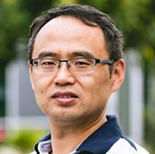
Prof. Shujun Zhang is a Distinguished Professor at the Institute for Superconducting and Electronic Materials, Australian Institute for Innovative Materials, University of Wollongong, Australia. Prior to this, he was a Professor at the Materials Science and Engineering Department and Senior Scientist at the Materials Research Institute of the Pennsylvania State University, USA. He is the IEEE fellow of UFFC-S (2021), a Fellow of the American Ceramic Society (2019), and a Future Fellow of the Australian Research Council (2015-2019). He delivered more than 130 invited/keynote/plenary presentations at international conferences, industries, and universities. He holds 11 US patents and has co-authored 580 papers in peer-reviewed journals. He is now focusing on the fabrication–microstructure–property–application relationship of electronic materials used for piezoelectric sensors, acoustic transducers, and energy storage/harvesting applications.
The following is a short Q&A with Prof. Shujun Zhang, who shared his vision for the journal with us, as well as his views of the research area and Open Access publishing:
1. What appealed to you about the journal that made you want to take on the role of its Section Editor-in-Chief?
I have been involved in the journal Crystals since 2014. I have been Section Editor-in-Chief for the Sections “Crystal Engineering” (2017-2018), “Crystalline Materials” (2018-2019), and “Inorganic Crystalline Materials” (2019-2022), and now I’m glad to serve as Section Editor-in-Chief for the newly launched “Polycrystalline Ceramics”, which is an important research direction in the field of Crystals. This will give me an opportunity to ensure the quality of articles and contribute to the success of the journal.
2. What is your vision for the Section?
The Section aims to attract papers in all aspects of polycrystalline ceramics, including ceramic processing and manufacturing, functional ceramics, engineering ceramics, structural ceramics, ceramic composites, microstructure characterization of ceramics, thermodynamic and kinetic studies of ceramics, reliability and stability of ceramics, and ceramic applications, etc. This Section will become a forum for discussing the current state-of-the-art and recent advances in ceramic exploration.
3. What does the future of this field of research look like?
We have a promising future in this research field since ceramics have been studied extensively for numerous applications, for meeting the current demand and fueling the transition to renewable energy, advanced technology, health, communication, and infrastructure. I would certainly like to see submissions to Crystals that are closely related to this type of expected outcome.
4. What do you think of the development of Open Access in the publishing field?
I believe that the Open Access model is a good way to ensure that quality research is quickly and broadly exposed to academia and industry alike, making new research results freely available online to an unlimited audience, thus creating an invaluable approach for research.
We warmly welcome Prof. Shujun Zhang as the new Section Editor-in-Chief and we look forward to him leading Crystals to reach many more milestones.


